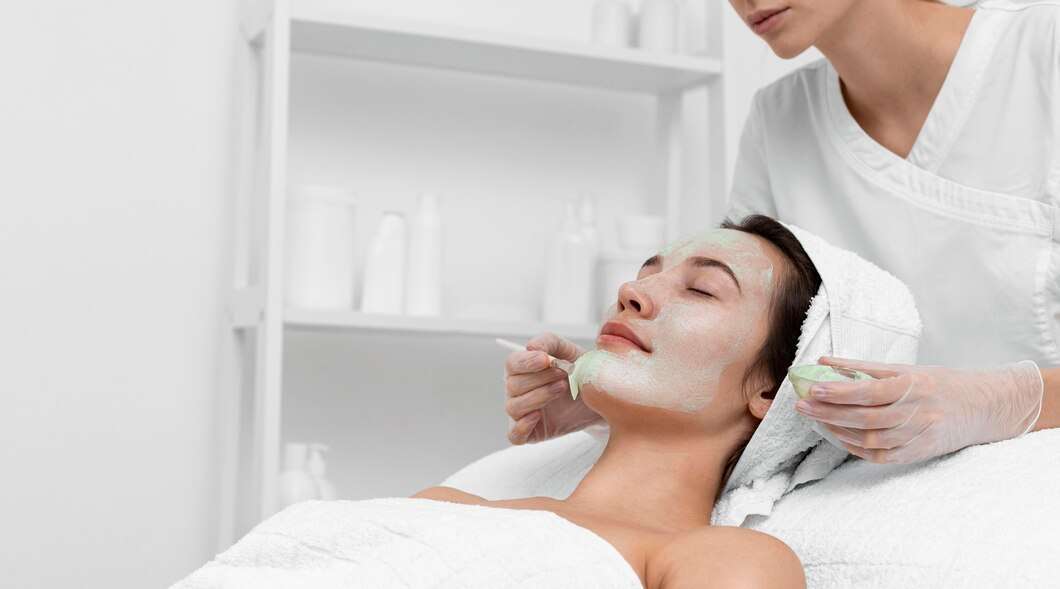The Science Behind Facial Treatments in Lubbock

The Science Behind Facial Treatments in Lubbock
In the heart of Lubbock, where the vibrant West Texas spirit meets modern innovation, lies a realm of rejuvenation and restoration: facial treatments. Beyond the soothing ambiance and luxurious pampering, there exists a captivating world of science intricately woven into every aspect of skincare. From combating signs of aging to addressing skin concerns, each treatment is meticulously crafted, drawing upon the latest advancements in dermatology and cosmetology.
In this blog series, we embark on an enlightening exploration into the science behind facial treatments in Lubbock. Delving deep into the mechanisms at play, we uncover the secrets behind glowing complexions and timeless beauty. Join us as we unravel the mysteries of skincare science, empowering you to make informed decisions and embark on your own journey to radiant skin.
Understanding Skin Physiology: The Foundation of Facial Treatments
At the core of effective facial treatments lies a profound understanding of skin physiology. Skin, the body’s largest organ, is a complex ecosystem influenced by genetics, environment, and lifestyle factors.
To tailor treatments effectively, skincare professionals delve deep into the intricacies of skin structure, function, and behavior. Understanding the epidermis, dermis, and subcutaneous layers is crucial for devising targeted solutions that address specific concerns such as acne, aging, or hyperpigmentation.
By comprehending how the skin functions and responds to various stimuli, practitioners can optimize treatment outcomes, ensuring each regimen is both safe and effective for diverse skin types.
The Role of Topical Ingredients: How Science Enhances Skincare Formulations
Skincare formulations are a delicate fusion of art and science, with each ingredient meticulously selected for its unique properties and benefits. Science plays a pivotal role in this process, guiding the selection and concentration of active compounds to maximize efficacy and safety.
From antioxidants that combat free radicals to retinoids that stimulate collagen production, every ingredient is backed by scientific research validating its role in skincare. Moreover, advancements in nanotechnology and delivery systems have enabled deeper penetration of active ingredients, enhancing their bioavailability and effectiveness.
By understanding the science behind topical ingredients, skincare professionals can craft formulations tailored to address specific skin concerns, promoting healthier, more radiant skin.
Targeting Specific Skin Concerns: A Scientific Approach to Treatment
Addressing specific skin concerns requires a systematic and scientific approach that goes beyond one-size-fits-all solutions. Whether combating acne, wrinkles, or uneven skin tone, understanding the underlying mechanisms driving these issues is paramount.
By analyzing factors such as inflammation, oxidative stress, and hormonal imbalances, skincare professionals can devise personalized treatment plans tailored to each individual’s unique needs. This scientific approach involves selecting interventions proven to target specific pathways or cellular processes responsible for the observed skin condition.
From prescription medications to advanced cosmetic procedures, the arsenal of tools available reflects the intersection of dermatology, cosmetology, and medical science, ensuring optimal outcomes for diverse skin concerns.
The Science of Exfoliation: Unveiling the Secrets of Renewed Skin

Exfoliation is a cornerstone of skincare, promoting the shedding of dead skin cells to reveal smoother, brighter skin underneath. At its core, exfoliation relies on the principles of cellular turnover and renewal, facilitated by various physical and chemical agents.
Physical exfoliants, such as scrubs or brushes, work by mechanically removing dead cells from the skin’s surface. In contrast, chemical exfoliants, like alpha hydroxy acids (AHAs) or beta hydroxy acids (BHAs), dissolve the bonds holding dead skin cells together, allowing them to be sloughed off more effectively.
Understanding the science behind exfoliation is crucial for selecting the appropriate method and frequency to avoid irritation or over-exfoliation, thereby achieving optimal results in skin texture and clarity.
Harnessing the Power of Peptides: Science-Backed Solutions for Aging Skin
Peptides are small chains of amino acids that play a crucial role in skin health and rejuvenation. These bioactive compounds function as signaling molecules, triggering various cellular processes involved in collagen synthesis, wound healing, and antioxidant defense.
In skincare formulations, peptides are hailed for their ability to address common signs of aging, such as fine lines, wrinkles, and loss of elasticity. By stimulating collagen production and enhancing skin repair mechanisms, peptides promote smoother, firmer, and more youthful-looking skin.
Moreover, scientific research continues to unveil novel peptide formulations with targeted benefits, such as peptide complexes designed to mimic the effects of Botox without the need for injections. Understanding the science behind peptides empowers skincare professionals to harness their full potential in combating the visible signs of aging.
Light Therapy: Illuminating the Science Behind LED Facial Treatments
Light therapy, also known as phototherapy, harnesses the therapeutic properties of specific wavelengths of light to promote skin health and rejuvenation. LED (Light Emitting Diode) facial treatments utilize different colors of light, each with unique biological effects on the skin.
For example, red light stimulates collagen production, reduces inflammation, and accelerates wound healing, making it ideal for anti-aging and post-treatment recovery.
Conversely, blue light targets acne-causing bacteria, effectively reducing breakouts and promoting clearer skin. The science behind LED therapy lies in its ability to penetrate the skin at different depths, activating cellular processes without causing damage.
By understanding the specific wavelengths and their corresponding effects, skincare professionals can customize LED treatments to address a myriad of skin concerns, from acne to aging, with remarkable efficacy and safety.
Microneedling: Exploring the Mechanisms of Collagen Induction Therapy
Microneedling, also known as collagen induction therapy, is a minimally invasive procedure that stimulates the skin’s natural healing response to promote collagen production and tissue remodeling. The science behind microneedling lies in the controlled creation of micro-injuries using fine needles, which triggers the release of growth factors and cytokines, initiating the wound healing cascade.
As the skin repairs itself, new collagen and elastin fibers are synthesized, resulting in improved skin texture, firmness, and elasticity. Additionally, microneedling enhances the penetration of topical skincare products, maximizing their efficacy and enhancing overall treatment outcomes.
Understanding the mechanisms of microneedling empowers skincare professionals to optimize treatment parameters and tailor regimens to address specific concerns, ranging from fine lines and wrinkles to acne scars and hyperpigmentation.
Chemical Peels: A Deep Dive into the Science of Skin Resurfacing
Chemical peels are cosmetic treatments that utilize exfoliating agents to induce controlled damage to the skin, leading to its regeneration and renewal. The science behind chemical peels lies in the selection and concentration of active ingredients, such as alpha hydroxy acids (AHAs), beta hydroxy acids (BHAs), and trichloroacetic acid (TCA), which penetrate the skin to varying depths, depending on their molecular size and concentration.
By causing the exfoliation of damaged and pigmented skin cells, chemical peels promote cellular turnover and collagen synthesis, resulting in smoother texture, improved tone, and reduced signs of aging.
Moreover, chemical peels can target specific concerns, such as acne, hyperpigmentation, and melasma, through customized formulations and treatment protocols. Understanding the science behind chemical peels enables skincare professionals to optimize safety and efficacy while tailoring treatments to individual skin types and concerns.
Hyaluronic Acid and Beyond: The Science of Hydration in Facial Treatments
Hydration is fundamental to skin health, influencing its elasticity, suppleness, and overall appearance. Hyaluronic acid, a naturally occurring molecule in the skin, plays a critical role in maintaining hydration by attracting and retaining water molecules.
In facial treatments, hyaluronic acid serves as a humectant, drawing moisture into the skin to plump and hydrate the epidermis. Additionally, scientific advancements have led to the development of hyaluronic acid-based dermal fillers, which replenish lost volume and restore youthful contours to the face.
Beyond hyaluronic acid, other hydrating ingredients, such as glycerin, ceramides, and amino acids, work synergistically to fortify the skin’s moisture barrier and prevent transepidermal water loss.
Understanding the science of hydration enables skincare professionals to select and formulate products that optimize skin hydration, promoting a healthy, radiant complexion.
Understanding Photorejuvenation: How Science Revitalizes Skin with IPL Therapy
Photorejuvenation, also known as Intense Pulsed Light (IPL) therapy, is a non-invasive cosmetic procedure that utilizes broad-spectrum light to target various skin concerns, including sun damage, age spots, and vascular lesions.
The science behind IPL therapy lies in selective photothermolysis, where light energy is absorbed by chromophores in the skin, such as melanin and hemoglobin, causing their destruction while sparing surrounding tissues.
This process triggers the skin’s natural healing response, leading to the gradual reduction of pigmentation irregularities, redness, and visible blood vessels. Moreover, IPL therapy stimulates collagen production, resulting in improved skin texture, tone, and elasticity over time.
Understanding the principles of photorejuvenation enables skincare professionals to customize IPL treatments to address specific concerns and achieve optimal results with minimal downtime and side effects.
As we conclude our enlightening journey into the science behind facial treatments in Lubbock, it’s evident that skincare is not merely a luxury but a fusion of art and science. From understanding skin physiology to harnessing the power of innovative treatments, each aspect contributes to achieving radiant, healthy skin. Armed with this knowledge, you are empowered to make informed decisions about your skincare regimen, ensuring it aligns with your unique needs and goals.
Are you ready to embark on your own journey to flawless skin? Whether you’re seeking to address specific concerns or simply indulge in a revitalizing skincare experience, our team of skincare professionals at American Laser Med Spa in Lubbock, TX, is here to guide you.
Contact us at 806-793-7700 or email us at Lubbock@americanlaser-medspa.com to schedule a consultation today. Let’s work together to unlock your skin’s full potential and embrace the science of skincare for a radiant, healthy complexion.






